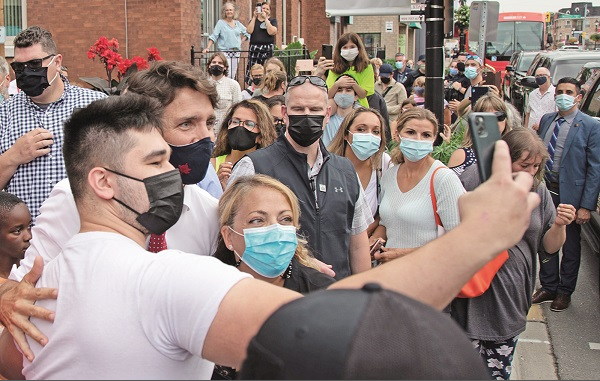The following article by Jack L. Rozdilsky, York University, Canada originally appeared on the Conversation and is published here with permission.
Prime Minister Justin Trudeau is back in power and the makeup of Parliament remains similar to how it was prior to the federal election. In the wake of the vote, the caustic protest language and aggressive actions that were directed at candidates during the campaign has raised questions around whether this was “a new brand of Canadian political violence.”
With the final tallies of the votes confirmed, a series of constitutional, conventional and practical steps are currently taking place to provide for the peaceful transition of power. It is taken for granted that after each and every election, a peaceful transfer of power will take place.
The 2020 United States presidential election challenges and the subsequent capitol insurrection serve as reminders that democracy is fragile. While not approaching the levels of dysfunction in the U.S., the 2021 federal election revealed that Canada is also subject to pressures of anti-democratic threats from within.
A cautionary tale
In the days following the June 2015 golden escalator ride when Donald Trump announced his run for the presidency, it was not imagined that five years and seven months later the capstone of the Trump presidency would be a refusal to commit to a peaceful transition of power, culminating in a siege on the U.S. Capitol.
Repeatedly underestimated as a wild card or silly showman, Trump muscled his way into power. In the meantime, a permissive environment was created for various violent extremists to attempt to halt the peaceful transition of power.
Are Canadian wild cards waiting in the wings?
The insurrectionist attack on the Capitol was not spontaneous. Existing anti-government groups, hate groups and adherents of far right ideologies overlapped with groups protesting COVID-19 vaccinations and lockdowns. Merging under the umbrella of supporting Trump, the more militant members of these groups converged to violently obstruct congressional procedures to certify the results of the 2020 election.
The final weeks of the Trump presidency featured unprecedented attacks on one of the world’s most visible and influential democracies. The cautionary tale is that it did happen, and the peaceful transfer of power was threatened.
Red flags in Canada
For Canada to shrug off election violence as a threat that died along with Trump’s presidency, or as a purely American ailment, is as dangerous as it is apathetic. While nowhere near the scale of the election chaos in the U.S., the Canadian 2021 federal election was marred with anti-democratic incidents.
Incidents ranged from smaller instances of intimidation to larger acts of outright violence. In total, these incidents did not threaten the integrity of the election or undermine the peaceful transition of power — this time.
Nonetheless no matter how small or isolated these incidents were, a red flag is waving that cannot be ignored.
The agitators protesting during the federal election were part of an anti-vaccine movement emerging from discontent with the management of the COVID-19 public health crisis. This movement’s characteristics include: distrust of the government and other institutions, animosity towards experts and authorities, cultural grievances, rejection of mainstream science and the creeping influence of extremism in public discourse.
During a campaign stop in London, Ont., the incumbent Prime Minister Trudeau was pelted by gravel as he boarded a bus after a campaign stop. After the incident, Trudeau dismissed the incident by saying: “There was little bits of gravel … It’s no big deal.”
Police have since laid charges of assault with a weapon on the alleged stone thrower, a man who had been a local riding association president for the People’s Party of Canada.
The gravel-throwing incident was in the context of what was referred to as a “rocky start” to Trudeau’s campaign. Challenges of electioneering were compounded with intense and vitriolic protests from anti-vaxxers in different parts of Ontario. And on Aug. 27, a Liberal campaign event in Bolton, Ont., was cancelled due to safety concerns.
The election ended with sentiments that a “deeply polarized” brand of politics has been brought to Canada’s doorstep.
What’s next?
With the election past, what will those people who fervently protested candidates do now that they no longer have an election at which they can direct their fervour. Will another iteration of this movement materialize in the future to harass candidates in the next election?
Should malcontents build on their limited success and attempt to mess up the outcome of future elections, an indecorously contested race can result in electoral chaos. It has been suggested that Canada’s constitution leaves gaps on how or when a prime minister assumes or leaves office, allowing competing theories of precedent and propriety to fill the vacuum.
While the outcomes of the 2021 federal election maintained the status quo, the discontent took a few baby steps in the direction of serious threats to the democratic process. One hopes this does not mature into a future election-related insurrection attempt taking place at the Centre Block of Parliament in Ottawa.![]()
Jack L. Rozdilsky, Associate Professor of Disaster and Emergency Management, York University, Canada
This article is republished from The Conversation under a Creative Commons license. Read the original article.



